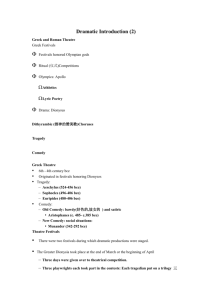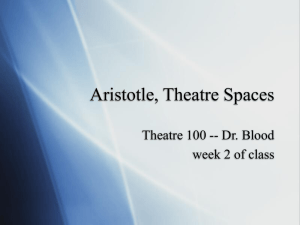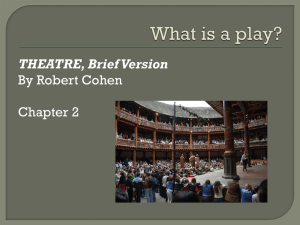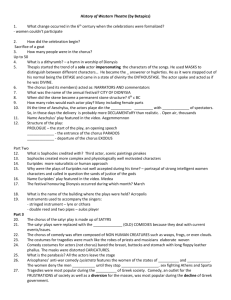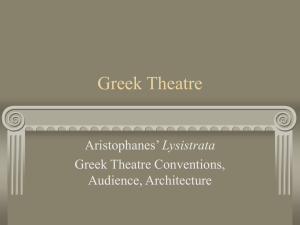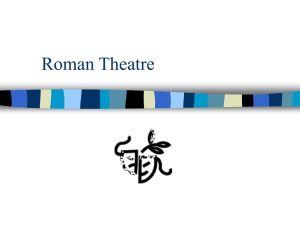Greek Theatre
advertisement
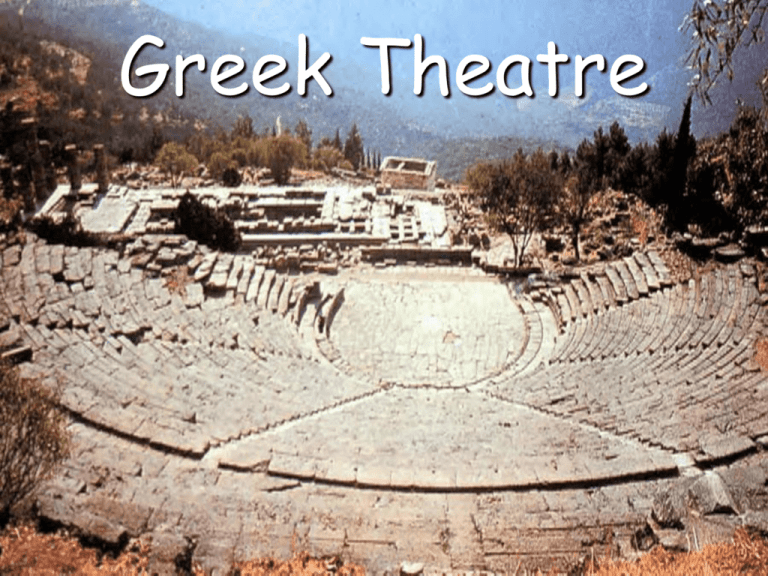
Greek Theatre Greek Festivals Festivals honored Olympian gods Ritual Competitions Olympics: Apollo Athletics Lyric Poetry Drama: Dionysos Dithyrambic Choruses Tragedy Comedy Greek Theatre 6th - 4th century bce Originated in festivals honoring Dionysos Tragedy: Aeschylus (524-456 bce) Sophocles (496-406 bce) Euripides (480-406 bce) Comedy: Old Comedy: bawdy and satiric Aristophanes (c. 485-c.385 bce) New Comedy: social situations: Menander (342-292 bce) Theatre Festivals The Greater Dionysia took place at the end of March or the beginning of April Three days were given over to theatrical competition. Three playwrights each took part in each contest Each tragedian put on a trilogy in the morning and each comic writer put on one comedy in the afternoon. The festival at Lenaes,staged at the end of January or the beginning of February, placed its emphasis on comedy Theatre at Epidaurus Curved seats may have aided acoustics ACTORS No tragedy used more than 3 actors All actors were male Costumes included character masks, and, in later years, raised boots Acting must have more expressive than realistic Greek Theatre Masks THE CHORUS: the voice of the citizens ORIGINS of TRAGEDY Tragedy, derived from the Greek words tragos (goat) and ode (song), told a story that was intended to teach religious lessons Tragedy arose from dithyrambic choruses. The dithyramb was an ode to Dionysus. It was usually performed by a chorus of fifty men dressed as satyrs -- mythological half-human, half-goat servants of Dionysus. In the 6th c. bce Thespis of Attica added an actor who interacted with the chorus. This actor was called the protagonist. In 534 BC, the ruler of Athens, Pisistratus, changed the Dionysian Festivals and instituted drama competitions. Thespis won the first competition in 534 BC. Dionysus and Satyr Tragic Tetralogies Each tragic dramatist had to present a trilogy of tragedies: connected narratively or dramatically The entire trilogy was performed in one day. The trilogy was followed by a satyr play - mocking and lightening the seriousness of the tragedies A Tetralogy, then, is a series of 4 plays: 3 tragedies and one satyr play TRAGIC STRUCTURE PROLOGOS: Introductory scene PARADOS: Entry of chorus EPISODEION STASIMON 4-5 alternating scenes and choral odes, including the PAEAN: a hymn of praise to the gods EXODOS: final scene EPODE: final ode. ARISTOTLE’S THREE UNITIES Aristotle’s On Tragedy is usually considered the first piece of Western dramatic criticism. In it, he proclaimed that tragedy must follow the 3 unities: UNITY OF TIME: one day UNITY OF PLACE: one setting UNITY OF ACTION: one plot Melpomene, the Muse of Tragedy AESCHYLUS 525-456 bce General in Persian Wars -- fought at Marathon, Salamis, Platea Fierce proponent of Athenian ideals The first of the great Athenian dramatists, was also the first to express the agony of the individual caught in conflict. Credited with adding the second actor Only extant trilogy: The Oresteia Agamemnon The Libation Bearers The Eumenides SOPHOCLES 496 - 406 bce Wrote over 100 plays, but only seven survive Credited with adding the third actor Known as actor as well as dramatist Most interested in human dynamics THEBAN PLAYS: Oedipus the King Antigone Oedipus at Colonnus EURIPIDES c.480-406 bce The last of the thee great Greek tragic dramatists -- 17 plays survive including Medea, The Trojan Women, The Bacchae Explored the theme of personal conflict within the polis and the depths of the individual Disgust with events of Peloponnesian War brought about disillusionment with Athens Men and women bring disaster on themselves because their passions overwhelm their reason TRAGIC ACTION ARETE, ARISTEIA: excellence HUBRIS: arrogance HAMARTIA: fatal mistake PERIPETEIA: reversal of fortune ANAGNORISIS: understanding KATHARSIS Roman mosaic of Aeschylus and Satyr play cast Ancient Comedy Scene from Lenaian Festival c. 490-480 bce ORIGINS of GREEK OLD COMEDY Arose from komos : songs of revelry, charms to avert evil, prayers for fertility sung to Dionysus Chorus dressed ludicrously Audience responded to choral komos and were gradually admitted into chorus Chorus became two-part group with antiphonal song Invention of comic chorus is attributed to Susarion Dorian and Sicilian farces were precursors of Old Comedy CONVENTIONS of OLD COMEDY Scene set on Athenian street “Events seldom occur – they are merely talked about” Masks and fantastic costumes Satiric of contemporary events and public figures Bawdy Scene from Aristophanes’ The Frogs COMIC STRUCTURE Prologos: introductory scene Parados: entry of 24 member chorus dressed in fantastic costume Agon: argument “just prior to the agon, the leader of the chorus always asks one contender to present his argument, and it is this contender who always loses” Parabasis: chorus’s great song Episodeion Stasimon 4-5 alternating scenes and choral odes illustrating the outcome of the agon Komos: final choral song and exit in wild revelry 30+ plays; 11 extant; 6 first prizes Plays include Clouds Wasps Birds Lysistrata Frogs Critiques of Euripides & Socrates: reactionary conservative; social critic Plato's epitaph for Aristophanes : “The Graces, seeking a shrine that could not fall, discovered the soul of Aristophanes.” ARISTOPHANES c. 448 - 380 BCE The Birds New Comedy By 317 BC, a new form had evolved that resembled modern farces: mistaken identities, ironic situations, ordinary characters and wit. Basic plot: Boy meets girl, complications arise, boy gets girl – ends with betrothal or marriage. 5 act structure: acts divided by interludes performed by the chorus Stock characters: young lovers, parasite, lecherous old men, clever servants, etc. Social rather than political satire Terracotta figurines of New Comedy actors 1905 a manuscript was discovered in Cairo that contained pieces of five Menander plays, and in 1957 a complete play, Diskolos (The Grouch, 317 BC), was unearthed in Egypt. Menander’s comedy with its emphasis on mistaken identity, romance and situational humor, became the model for subsequent comedy, from the Romans to Shakespeare to Broadway. MENANDER 342-292 bce Mosaic of Menander’s Samia Parts of Menander’s comedies found their way into plays by Roman playwrights: Plautus and Terence Shakespeare's Comedy of Errors Stephen Sondheim's A Funny Thing Happened on the Way to the Forum. Roman Theatre ROMAN THEATRE Drama flourished under the Republic but declined into variety entertainment under the Empire Roman festivals: Held in honor of the gods, but much less religious than in Greece Ludi Romani Became theatrical in 364 B.C. Held in September (the autumn)and honored Jupiter. By 240 B.C., both comedy and tragedy were performed. Five others: Ludi Florales (April), Plebeii (November), Apollinares (July), Megalenses (April), Cereales (no particular season). Under the Empire, these festivals afforded "bread and circuses" to the masses – many performances. —including a series of plays or events. Acting troupes (perhaps several a day) put on theatre events. ROMAN THEATRE Encompassed more than drama : acrobatics, gladiators, jugglers, athletics, chariots races, naumachia (sea battles), boxing, venationes (animal fights) Entertainment tended to be grandiose, sentimental, diversionary Actors / performers were called histriones Fresco with theatre masks Roman Theatre Design First permanent Roman theatre built 54 ce (100 years after the last surviving comedy) So permanent structures came from periods after significant writing More that 100 permanent theatre structures by 550 ce. Built on level ground with stadium-style seating (audience raised) Could seat 10-15,000 people Awning over the audience to protect them from the sun During the Empire around 78 ce, cooling system installed– air blowing over streams of water Artist’s Impression of the Roman Theatre of Verulamium : Britain circa CE 180, excavated in 1847 by Alan Sorrell ROMAN COMEDY Chorus was abandoned No act or scene divisions Songs Everyday domestic affairs: Boy meets girl, complications, boy gets girl: marriage Action placed in the street Bawdy Stock characters Only two playwrights' material survives: Plautus (c. 254-184 bce) Terence (195 or 185-159 bce) Thalia, the Muse Of Comedy STOCK CHARACTERS Senex: old man in authority Pappas: foolish old man Bucco: braggart, boisterous Miles gloriosus: braggart soldier Dossenus: swindler, drunk, hunchback Shrew: sharp-tongued woman Courtesan Clever servant Young Lovers 21 extant plays including Pot of Gold, The Menaechmi, Braggart Warrior -- probably between 205-184 B.C. All based on Greek New Comedies Added Roman allusions, Latin dialog, varied poetic meters, witty jokes Some techniques: Stychomythia – dialog with short lines, like a tennis match Slapstick Songs PLAUTUS Titus Maccius Plautus c. 254-184 B.C.E. Born in Carthage, came to Rome as a boy slave, educated and freed The Afer in his name may indicate that he was an African, and Publius Terenius Afer therefore he may have been the first major black playwright in (195 or 185-159 B.C.E.) western theater. Six plays, all of which survive including The Brothers, Mother-inLaw, etc. More complex plots – combined stories from Greek originals. Character and double-plots were his forte – contrasts in human behavior Less boisterous than Plautus, less episodic, more elegant language. Less popular than Plautus. TERENCE Roman Tragedy None survive from the early period, and only one playwright from the later period: Seneca 5 act structure – later adopted by Elizabethans Elaborate speeches -rhetorical influence Interest in morality – expressed in sententiae (short pithy generalizations about the human condition) Medea, Herculaneum c. 70 bce Roman philosopher, orator, dramatist and statesman Nine extant tragedies, five adapted from Euripides:The Trojan Women, Medea, Oedipus, Agamemnon Suicide in 65 A.D.– at the orders of Nero Seneca had a strong effect on later dramatists. Uncertain whether Seneca's plays were actually performed or simply intended for recitation before a small private audience: closet dramas SENECA Lucius Annaeus Seneca (5 or 4 B.C.E.– 65 C.E.) Roman Spectacle Gladiatorial combats Chariot races Naumachia: Naval battles in a flooded Coliseum “Real-life” theatricals Decadent, violent and immoral All theatrical events banned by Church when Rome became Christianized The End
